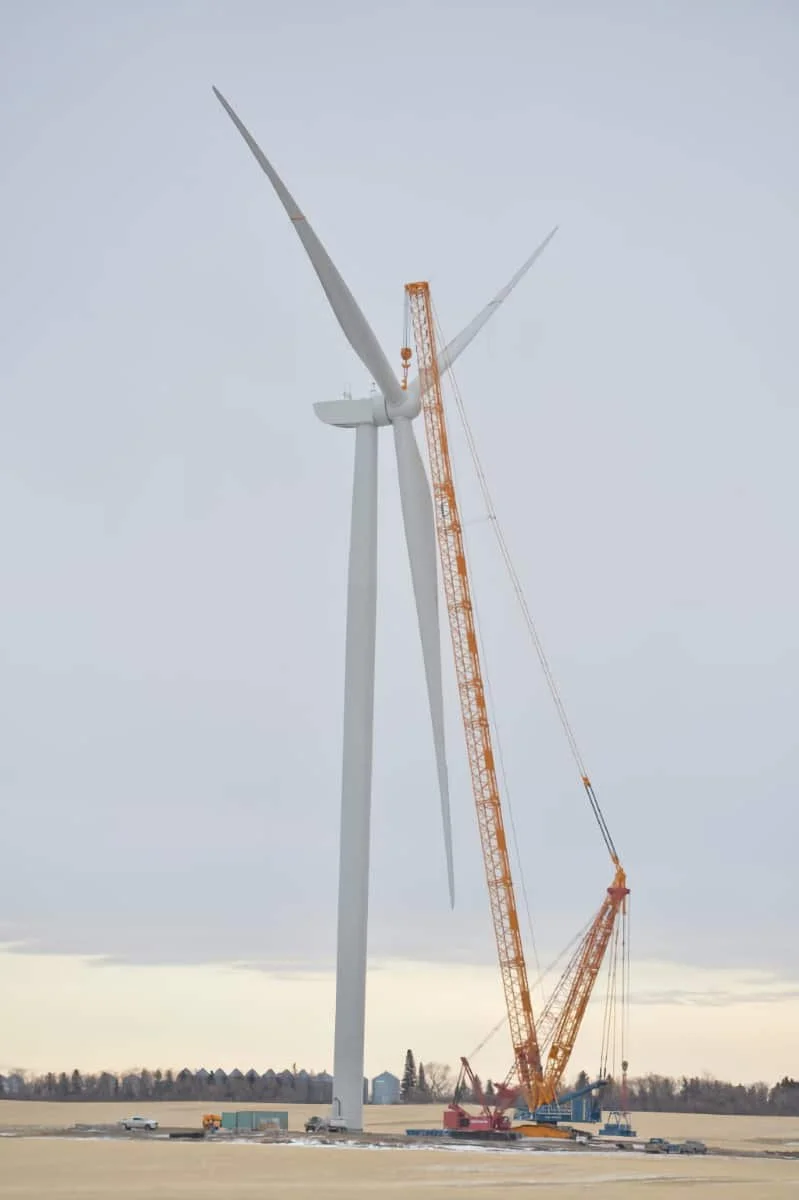Just as Alberta has had minimal wind power, so, too has Saskatchewan
By Brian Zinchuk
Wind power generation in Alberta has flatlined twice in as many days, and as weather patterns typically flow from west to east, Saskatchewan has seen similar conditions.
On Sunday, Feb. 4, Alberta saw wind power generation fall to 15 megawatts during the supper hour. On Feb. 5, wind fell to less than 1 per cent output before noon and remained at that level (and much lower) for almost all of the next 24 hours.
Assembly of a wind turbine near Assiniboia, Sask., on Jan. 7, 2021. Photo by Brian Zinchuk
So what happened in Saskatchewan? Pipeline Online asked SaskPower, and got this response on Feb. 6 from spokesperson Joel Cherry by email. In situations like this, Pipeline Online usually asks how long the province’s 617 megawatts of grid-scale wind produces zero power, and how long it produces less than 10 megawatts (1.6 per cent), which is effectively zero.
Cherry said, “On Feb 4 we had about an hour of less than 10 megawatts of wind from 12 a.m. to 1 a.m.
“Yesterday (Feb. 5) we had less than 10 megawatts from 1:30 p.m. to 6:45 p.m., from 8:15 p.m. to 9 p.m. and then from 9:45 to midnight. We were at zero for much of the afternoon and then from 10:45 to midnight. We did have wind production in the 100-150 MW range throughout much of the morning up to 10 a.m. before winds died off for the day.”
Alberta’s flatlined wind power production meant the province was importing power from its neighbours, a frequent occurrence of back-and-forth trade. The intertie between the two provinces had been downrated several months ago to 90 megawatts until some maintenance was completed. During the mid-January electrical crisis in Alberta, the capacity of the line was temporarily pushed back to 153 megawatts to help Alberta get through its critical shortage, before returning back to 90 megawatts.
Those repairs are now done, Cherry said. “We did start exporting full tie of 153 once the tie-line with Alberta was back to full capacity, which occurred yesterday (February 5). It was not an emergency exception.”
As part of those regular electrical market exchanges, SaskPower also imported power from Manitoba Hydro. Cherry said, “We imported between 290 megawatts and 148 megawatts from Manitoba during that time period, with our total net imports ranging from 132 megawatts at 7:45 p.m. to four megawatts at midnight.”
On Feb. 4, Saskatchewan’s 30 megawatts of grid-scale solar showed negligible power generation. So on that day, not only were periods of next to no wind power, but also no solar, at the same time.
Part of a 2014 equivalency agreement with the then-Conservative federal government allowed SaskPower to extend the life of its coal-fired power generation assets a few more years. In return, the province committed to expanding wind and solar power generation by an additional 3,000 megawatts by 2035. Currently a 200 megawatt wind project called the Bekevar Yōtin Wind Facility is under construction at Kipling, and a 100 megawatt solar project was recently announced for Estevan. Both are being built by independent power producers who will sell their power to SaskPower.
On Sept. 25, 2023, SaskPower president and CEO Rupen Pandya told Pipeline Online, “When we signed the equivalency agreement with the federal government in 2014 to allow us to keep using coal to the end of 2030, part of that agreement required us to build out renewables in the province, so that we could operate coal assets, coal generators, past their end of life. And that’s what we’ve been able to do. And we continue to do. So, part of the build out of renewables that’s required as part of the equivalency agreement, that 3,000 megawatts that we need to put in place by 2035. I think 2,000 by 2030.”
The proposed federal Clean Electricity Regulations intend to phase out unabated coal and natural gas power generation in Canada by 2035. In Saskatchewan on Feb. 4, natural gas and coal accounted for 88 per cent of power generation, combined. In Alberta, Tuesday morning, it was 96 per cent (mostly natural gas, with some coal).

